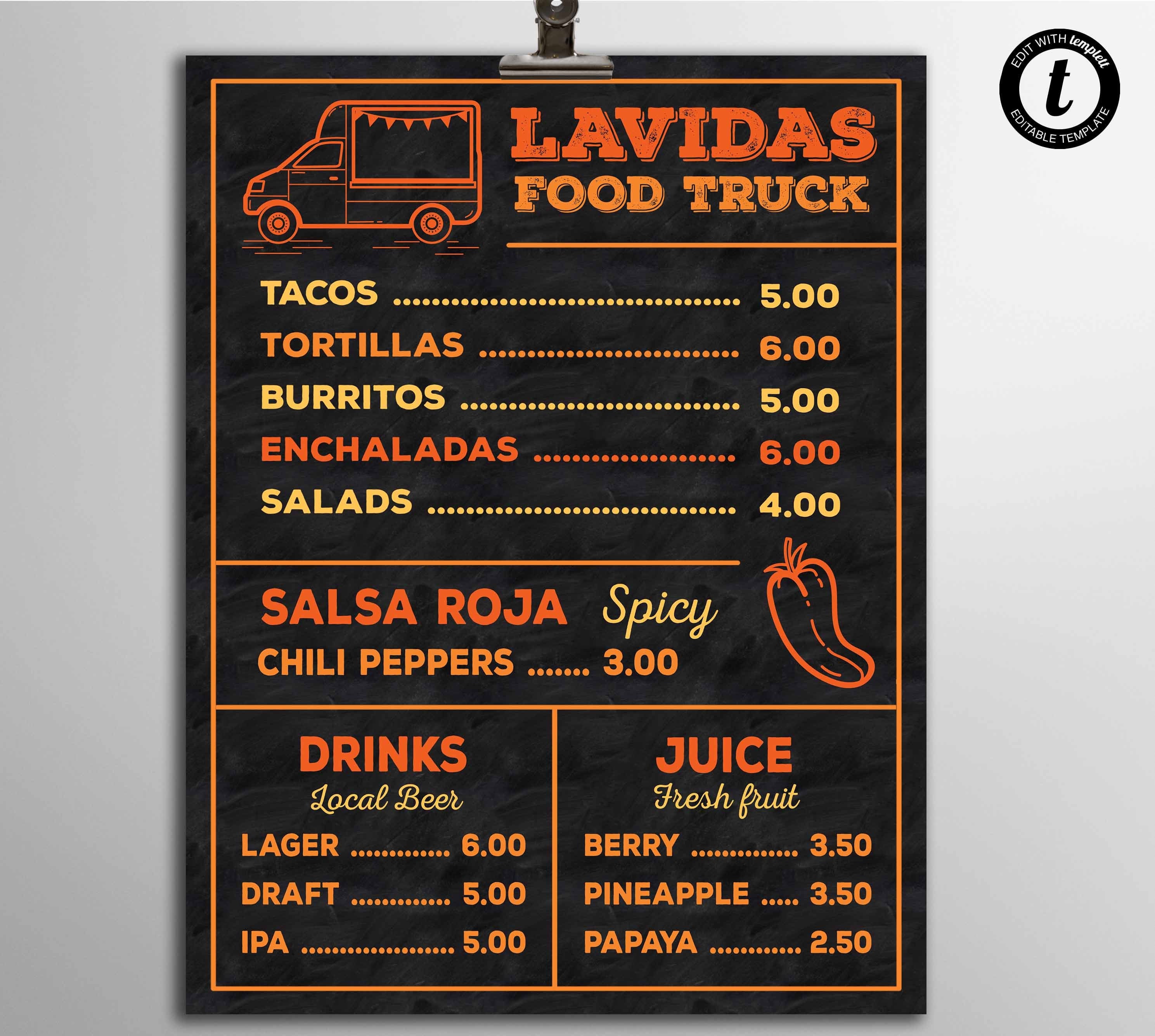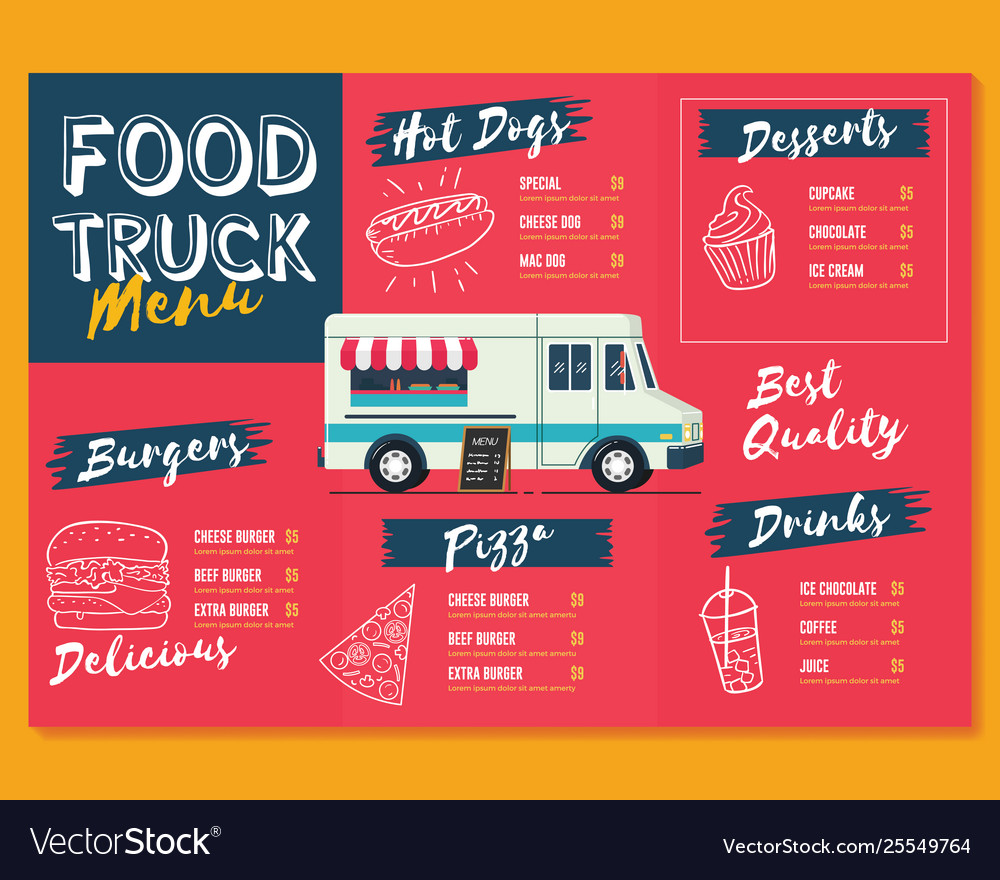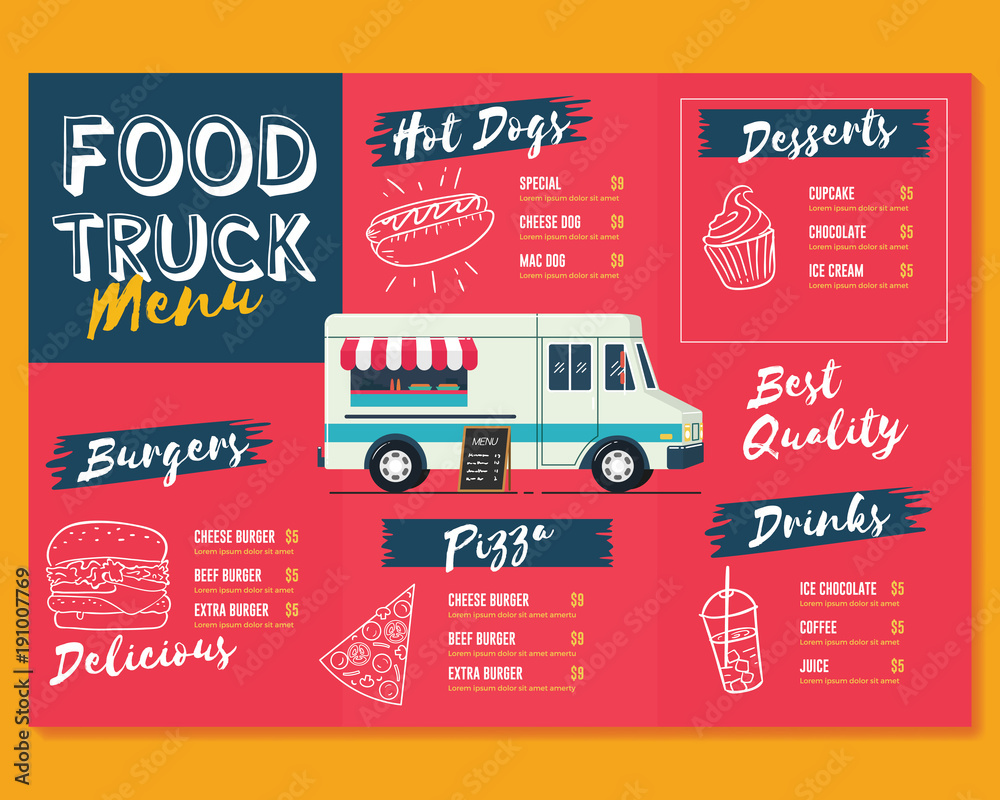Food truck menus, the culinary calling cards of these mobile eateries, are not just lists of dishes; they are masterpieces of marketing and persuasion, designed to tantalize taste buds and drive sales. In this comprehensive guide, we delve into the art of crafting food truck menus that not only showcase your culinary creations but also optimize your business for success.
From visually appealing designs to persuasive descriptions, from strategic pricing to data-driven optimization, we cover every aspect of menu creation to empower you to create menus that are as irresistible as your food.
Food Truck Menu Design: Food Truck Menus

The menu is a crucial element of any food truck, as it serves as a visual representation of the culinary offerings and sets the tone for the dining experience. Creating a visually appealing and informative menu is essential to attract customers and effectively communicate the food options available.
Menu Size and Layout
The size and layout of the menu should be carefully considered. A menu that is too large can be overwhelming, while a menu that is too small may not provide enough information about the dishes. The layout should be clear and easy to navigate, with dishes grouped into logical categories and prices prominently displayed.
Color Schemes
The color scheme of the menu should be visually appealing and consistent with the overall branding of the food truck. Bright and vibrant colors can attract attention, while more subdued colors can create a more sophisticated atmosphere. It is important to choose colors that complement the food photography and create a cohesive visual experience.
Clear and Concise Menu Descriptions
The descriptions of each dish should be clear and concise, providing customers with enough information to make an informed decision. Avoid using excessive jargon or technical terms that may not be understood by all customers. Instead, use simple and descriptive language that highlights the key ingredients and flavors of each dish.
Menu Item Categorization
Organizing menu items into logical categories is crucial for enhancing the customer experience and increasing sales. Categorization helps customers navigate the menu effortlessly, find what they’re looking for quickly, and make informed decisions.
Sections and subcategories within the menu provide a structured framework for presenting items. This allows customers to narrow down their choices based on their preferences, dietary restrictions, or specific cravings. It also helps prevent overwhelming customers with an extensive list of items.
Benefits of Menu Categorization
- Enhanced customer navigation and satisfaction
- Increased sales by guiding customers towards desired items
- Improved order accuracy by reducing confusion
- Efficient use of menu space, allowing for more items to be displayed
Effective Menu Categorization
When categorizing menu items, consider the following guidelines:
- Use clear and concise category names:Customers should be able to understand the category at a glance.
- Group similar items together:Place items that share common characteristics, such as ingredients, flavors, or preparation methods, within the same category.
- Limit the number of categories:Too many categories can overwhelm customers. Aim for a balance that provides enough options without creating confusion.
- Use subcategories when necessary:Subcategories can further refine categories and help customers narrow down their choices.
Examples of Effective Menu Categorization
Here are some examples of effective menu categorization:
- Appetizers:Small dishes served before the main meal, such as salads, soups, and finger foods.
- Entrees:Main courses, typically featuring a protein and sides, such as burgers, tacos, and pasta dishes.
- Sides:Accompaniments to entrees, such as fries, rice, and vegetables.
- Desserts:Sweet dishes served after the meal, such as cakes, pies, and ice cream.
Menu Item Descriptions
Crafting compelling menu item descriptions is an art form that can entice customers and drive sales. By using descriptive language, sensory details, and highlighting the benefits of each dish, you can create descriptions that make your food irresistible.
Descriptive language paints a vivid picture in the customer’s mind, evoking their senses and making them crave your dishes. For example, instead of simply listing “Tacos,” you could write “Tender, marinated chicken or savory grilled steak nestled in warm corn tortillas, topped with crisp lettuce, juicy tomatoes, and creamy avocado.”
This description appeals to the customer’s senses of taste, smell, and texture, making them more likely to order the tacos.
Sensory Details
Sensory details are crucial in creating mouthwatering descriptions. Use words that evoke the five senses: sight, sound, smell, taste, and touch. For example, describe the “sizzling” sound of fajitas as they hit the grill or the “melt-in-your-mouth” texture of a juicy burger.
These details make the customer feel like they are already experiencing the dish, increasing their desire to try it.
Benefits
Highlighting the benefits of each dish can persuade customers to choose your food truck over others. For example, emphasize the health benefits of your dishes, such as “made with fresh, locally sourced ingredients” or “packed with protein and fiber.” You can also mention the convenience factor, such as “perfect for a quick and satisfying meal on the go.”
Examples of Well-Written Descriptions
- “Fluffy buttermilk pancakes topped with warm blueberry compote and a drizzle of sweet maple syrup, a perfect start to your day.”
- “Juicy, flame-grilled burgers made with 100% Angus beef, served on a toasted brioche bun with your choice of toppings.”
- “Crispy fish tacos with lightly battered cod, shredded cabbage, and a zesty lime crema, a taste of the ocean in every bite.”
Menu Pricing Strategies
Effective menu pricing is crucial for the success of any food truck. It involves determining the appropriate price for each menu item based on various factors such as costs, market demand, and competition.
Cost-Plus Pricing
Cost-plus pricing is a simple method where the price of an item is calculated by adding a fixed percentage or markup to the cost of producing it. This ensures a profit margin and covers operating expenses.
Value-Based Pricing
Value-based pricing focuses on the perceived value of the menu item to the customer rather than its cost. It considers factors such as the item’s uniqueness, quality, and desirability when setting prices.
Competitive Pricing
Competitive pricing involves setting prices in line with or slightly below those of competitors. This strategy is often used to attract customers who are price-sensitive or to gain market share.
Importance of Menu Item Profitability
It is essential to ensure that each menu item is profitable. This means considering not only the direct costs of ingredients and labor but also indirect costs such as rent, utilities, and marketing.
Examples of Effective Menu Pricing, Food truck menus
- A food truck specializing in gourmet burgers may use value-based pricing to justify higher prices for premium ingredients and unique flavor combinations.
- A truck offering a variety of tacos may use cost-plus pricing to ensure a consistent profit margin on all items.
- A food truck operating in a competitive market may use competitive pricing to attract customers who are looking for affordable options.
Menu Optimization for Online Ordering

In today’s digital age, optimizing menus for online ordering platforms is crucial for food trucks. Online menus offer convenience and accessibility to customers, increasing the likelihood of orders and sales.
To create user-friendly online menus, consider the following tips:
Menu Structure
- Organize menu items into clear and concise categories, making it easy for customers to navigate.
- Use descriptive headings and subheadings to guide customers through the menu.
- Avoid overwhelming customers with too many options; consider creating a curated online menu that highlights popular items.
Visual Appeal
- Incorporate high-quality images of your dishes to enhance visual appeal and entice customers.
- Use bright and contrasting colors to draw attention to important items or promotions.
- Consider using a consistent design theme throughout the menu to create a cohesive brand experience.
Descriptions and Pricing
- Provide detailed descriptions of each menu item, highlighting key ingredients, flavors, and preparation methods.
- Clearly display prices for each item, including any applicable taxes or fees.
- Consider offering upsell options or combo deals to increase average order value.
Menu Analysis and Data Collection

Effective menu analysis involves collecting customer feedback and leveraging data analytics to track menu performance. By understanding customer preferences and menu performance metrics, food truck owners can make informed decisions to optimize their menu.
Customer Feedback Collection Methods
- Surveys:Create online or paper surveys to gather feedback on specific menu items, overall menu satisfaction, and suggestions for improvements.
- Online Reviews:Monitor online platforms such as Yelp, Google My Business, and social media for customer reviews and feedback.
- Direct Feedback:Encourage customers to provide feedback in person or via phone calls, allowing for immediate responses and clarification.
- Observation:Observe customer behavior, such as what items are ordered most frequently, which items are left uneaten, and how long customers spend reviewing the menu.
Data Analytics for Menu Performance Tracking
- Sales Data:Track sales data for each menu item to identify popular and underperforming items.
- Average Transaction Value:Calculate the average amount spent by customers per order to assess menu profitability.
- Customer Lifetime Value:Determine the value of repeat customers to understand the impact of menu satisfaction on customer loyalty.
- Web Analytics:Use website analytics to track menu page views, click-through rates, and conversion rates to identify popular menu items online.
Menu Data Analysis for Informed Decisions
By analyzing menu data, food truck owners can make informed decisions such as:
- Identifying menu items that need improvement or removal.
- Adjusting prices based on customer feedback and demand.
- Introducing new menu items that align with customer preferences.
- Optimizing menu layout and presentation to enhance customer experience.
Q&A
What is the most important element of a food truck menu?
Clarity and conciseness are paramount. Customers should be able to quickly and easily understand what you offer.
How can I optimize my menu for online ordering?
Use high-quality images, provide detailed descriptions, and make sure your menu is mobile-friendly.
How often should I update my menu?
Regularly update your menu to reflect seasonal availability, customer feedback, and new culinary creations.

